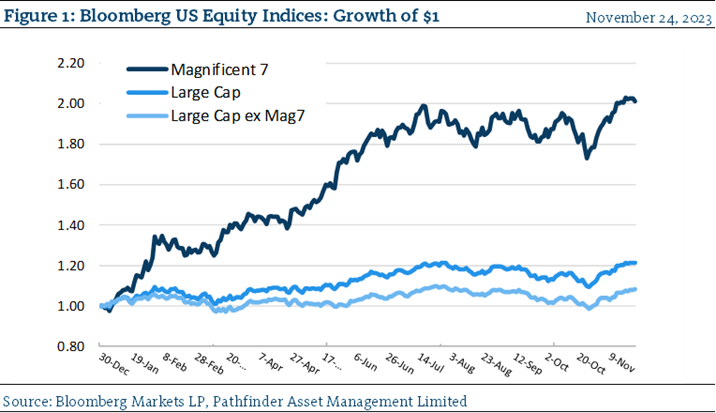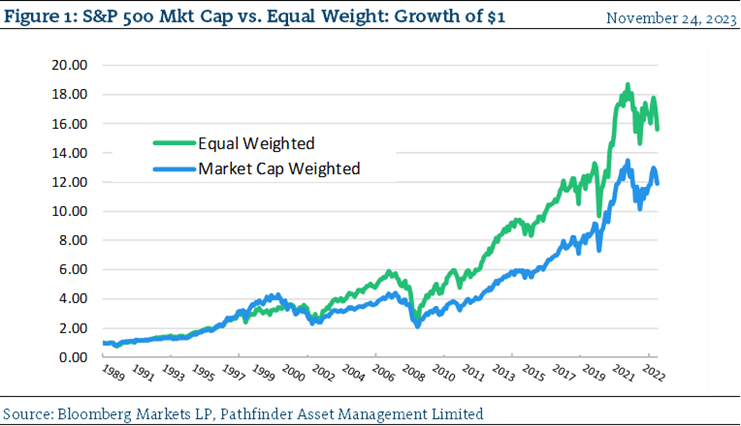The Magnificent 7
While we have not mentioned it in our weekly notes before, keen readers of the financial press will be aware of the Magnificent 7, which is a group of US stocks that have significantly distorted broad equity index returns this year. The list includes well recognized names: Alphabet, Amazon, Apple, Meta, Microsoft, Nvidia and Tesla. When you compare the returns of these companies against the rest of the large companies in the US, they have accounted for a large part of “market” returns of 2023. Herein lies the paradox for portfolio managers. Many investors compare themselves to benchmarks that are market capitalization weighted. This means the returns of each stock are weighted by the size of the company: as calculated by taking the quoted price of the company’s shares on an exchange and multiplying it against the total number of shares outstanding. This means that the largest companies have the most impact on the return of the index (positive or negative). This is comparatively different to an equal-weighted index, where all stocks are weighted the same. There is an on-going debate about which measurement is better, and while we do not have enough space in our note to give this debate justice, our general opinion is that the equal weight measurement is more appropriate.
- Figure 1 presents the dispersion between the returns of the Magnificent 7, the regular index, and the 7 companies removed. As you can see, this year, the difference is dramatic.

- Figure 2 presents a longer view of the cap and equal weighted indices (early 1990s). Equal is better, but also harder for fund companies to replicate.

“This means that” like other times in history (Nortel, Dotcom, Valeant, Canadian Banks), there is once again an index with distorted returns. Pathfinder is fortunate enough to be long-term investors in many of the Magnificent 7 names. While we struggle with valuations and their future position in the portfolios, we continue watching the evolution of the businesses with awe. We are happy that they are represented in a number of our portfolios and funds but also focused on when “the party will end”.
National Instrument 31-103 requires registered firms to disclose information that a reasonable investor would expect to know, including any material conflicts with the firm or its representatives. Doug Johnson and/or Pathfinder Asset Management Limited are an insider of companies periodically mentioned in this report. Please visit www.paml.ca for full disclosures.
Changes in Leverage. We are increasing the asset ceiling to 2.0 times the market value of equity for Pathfinder International Fund and Pathfinder Real Fund to be consistent with Pathfinder Partners’ Fund and Pathfinder Resource Fund.
*All returns are time weighted and net of investment management fees. Returns from the Pathfinder Partners’ Fund and Partners’ Real Return Plus Fund are presented based on the masters series of each fund. The Pathfinder Core: Equity Portfolio and The Pathfinder Core: High Income Portfolio are live accounts. These are actual accounts owned by the Pathfinder Chairman (Equity) and client (High Income) which contain no legacy positions, cash flows or other Pathfinder investment mandates or products. Monthly inception dates for each fund and portfolio are as follows: Pathfinder Core: Equity Portfolio (January 2011), Pathfinder Core: High Income Portfolio (October 2012) Partners’ Fund (April 2011), Partners’ Real Return Plus Fund (April, 2013), and Partners’ Core Plus Fund (November 2014).
Pathfinder Asset Management Limited (PAML) and its affiliates may collectively beneficially own in excess of 10% of one or more classes of the issued and outstanding equity securities mentioned in this newsletter. This publication is intended only to convey information. It is not to be construed as an investment guide or as an offer or solicitation of an offer to buy or sell any of the securities mentioned in it. The author has taken all usual and reasonable precautions to determine that the information contained in this publication has been obtained from sources believed to be reliable and that the procedures used to summarize and analyze such information are based on approved practices and principles in the investment industry. However, the market forces underlying investment value are subject to sudden and dramatic changes and data availability varies from one moment to the next. Consequently, neither the author nor PAML can make any warranty as to the accuracy or completeness of information, analysis or views contained in this publication or their usefulness or suitability in any particular circumstance. You should not undertake any investment or portfolio assessment or other transaction on the basis of this publication, but should first consult your portfolio manager, who can assess all relevant particulars of any proposed investment or transaction. PAML and the author accept no liability of any kind whatsoever or any damages or losses incurred by you as a result of reliance upon or use of this publication.